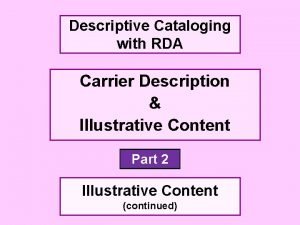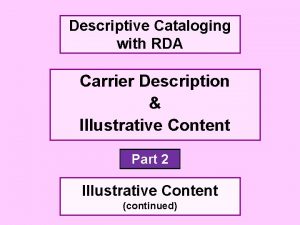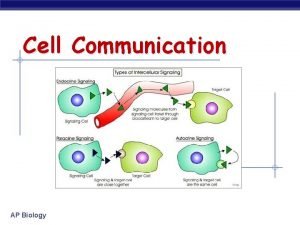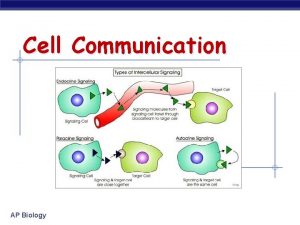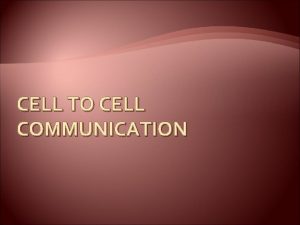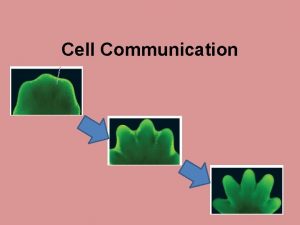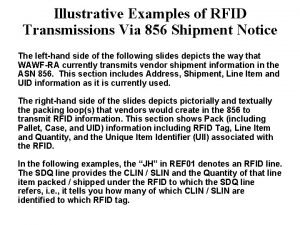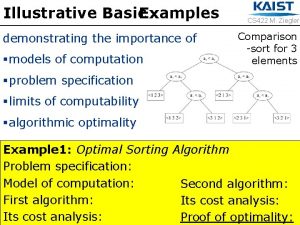4 1 Cell Communication Illustrative Examples Period 3

































- Slides: 33

4. 1 Cell Communication Illustrative Examples Period 3

What are Immune cells are cells that help defend against illness These cells in particular communicate through cell to cell contact. They attempt to detect and destroy anything that seems unfamiliar. (Good and Bad; viruses and blood donations) Various different types, However we will be focusing on 3

Antigen Presenting Cells (APCs) Antigen-presenting cells (APCs) are a heterogeneous group of immune cells that mediate the cellular immune response by processing and presenting antigens for recognition by certain lymphocytes such as T cells. Give the protein for the t cells to put for memory and search for they identify the proteins for t cells for the first time. This means that APC’s are what tell the T cells what to do If the T-Cells are giant brutes who can destroy anything, APCs are the kingpins telling them where to go and Helper T-Cells are the ones giving the APCs the tools that are necessary in order to do the job. Basically, you’re immune system is like the neighborhood watch, and viruses are bad indiviuals. The APC’s are like the watch that is looking for bad eggs and then showing them to the leader of neighborhood watch, the helper t cell, which tell the police, the killer t cell, to move the negative influence out of the neighborhood.

Helper T-cells These cells don’t kill the viruses directly but are valuable team players in fighting off diseases. They use chemical messages to give instructions to the other immune system cells. These instructions are given to TCells and B-Cells in order to maximize their production to fight off the viruses. When a T-cell finds its virus match in your body, it makes many copies of itself to attack that virus. Think of them as the waterboys of the immune system They don’t score points but without them the players Would have a much harder time doing their job.

Killer T-cells Killer T-Cells are the cells that find and destroy the infected cells They use antigens to find the difference between virus containing cells and healthy cells. These antigens basically flag which cells are bad by looking for cells which don’t have a signal indicating they are good. Once they’re bound to the virus cells, the killer T-cells dispatch cytotoxins to kill the flagged cells. As you can imagine, misflagging cells can have catastrophic results the source of many diseases such as Hay fever, hypothyroidism, and Addison's disease aaaaa for the body, and this is

Here we see a T-cell attacking a Cancer cell https: //www. youtube. com/watch? v=jg. JKa. P 0 Sj 5 U

What is are plasmodesmata? Narrow membrane-lined channels that pass through the cell wall and connect the cytoplasm of two plant cells Allow communication between all the connected plant cells in a plant

Limitations - only water, small molecules(sugars and ions), and small signaling molecules can pass through - plasmodesmata are not passive channels and are highly controlled by many developmental factors

Connections - - - connect directly to each plant cell by the cytoplasm literally being continuous through each plant cell They are found in grouped clusters called pits in the thinner part of the cell wall It can branch out depending on the molecules needed to be transported

Continuous and Discontinuous Environments - - The continuous environment of the plasmodesmata is called the SYMPLASTIC PATHWAY (through the cytoplasm) The discontinuous environment of the plasmodesmata is called the APOPLASTIC PATHWAY (through the cell wall)

Why they are essential. . . - - - Transport proteins that convert RNA to DNA to support tissue growth and development The communication that plasmodesmata provide for plant cells is essential for growth and patterning Without plasmodesmata, vital materials and signaling molecules wouldn’t be transported throughout the plant’s cells

Neurotransmitters a chemical substance that is released at the end of a nerve fiber by the arrival of a nerve impulse and, by diffusing across the synapse or junction, causes the transfer of the impulse to another nerve fiber, a muscle fiber, or some other structure.

. neurotransmitters are synthesized and stored in vesicles at the end of the axon terminal.

When an electrical signal reaches the axon terminal of a nerve cell, neurotransmitters are released into the synapse and taken up by the receptors in nearby nerve cells. electrical impulses and chemical transmitters move information through a network of nerve cells in a very short period of time. Neurotransmitters can be excitatory, stimulating the receptors to send more impulses. inhibitory, decreasing the activity of the receptors. The binding of an excitatory neurotransmitter opens ion channels in nearby nerve cells, releasing more neurotransmitters.

7 main types: . acetylcholine. dopamine. norepinephrine. serotonin. GABA. Glutamate. Endorphin Each of these neurotransmitters serves a different purpose

acetylcholine A neurotransmitter used by neurons in the control of functions ranging from muscle contraction and heart rate to digestion and memory.

norepinephrine A neurotransmitter involved in arousal, as well as in learning and mood regulation.

serotonin A neurotransmitter used by cells in parts of the brain involved in the regulation of sleep, mood and eating.

dopamine A neurotransmitter used in the parts of the brain involved in regulating movement and experiencing pleasure.

GABA inhibits the firing of neurons

glutamate An excitatory neurotransmitter that helps strengthen synaptic connections between neurons.

endorphin bind to opiate receptors and moderate pain

Three stages of cell signaling ● ● ● Cell signaling is part of any communication process that governs basic activities of cells and coordinates multiple-cell actions The ability of cells to perceive and correctly respond to their microenvironment is the basis of development, tissue repair, and immunity, as well as normal tissue homeostasis In reception, a signal molecule, also known as a ligand, binds to a receptor protein in a lock and key fashion, causing the receptor to change shape

Three stages of cell signaling ● ● In transduction, the signal is converted into a form that can produce a cellular response Cascades of molecular interactions relay signals from receptors to target molecules in the cell Multistep pathways ○ Can amplify a signal (amplifies the signal by activating multiple copies of the next component in the pathway) ○ Provide more opportunities for coordination and regulation At each step in the pathway, the signal is transduced into a different form, commonly a conformational change in a protein

Three stages of cell signaling ● In response, the transduced signal triggers a cellular response

Plant immune response to pathogens ● ● ● ● Plants and pathogens have co-evolved Pathogens can recognize plants by the sugars and other molecules that they produce Plants in turn can recognize pathogens by the molecules that they produce The ability to recognize pathogens allows plants to activate defense systems that can prevent widespread infection A plant may recognize the molecules of a pathogen directly or indirectly Some pathogen molecules, for example, bind directly to plant receptors in the plasma membrane Others, such as enzymes, break down molecules within the plant cell wall, and then these broken-down products bind to plant receptors

Plant immune response to pathogens ● ● ● When molecules bind to the plant receptors, these receptors become activated and trigger a cascade of reactions These reactions lead to the production of second messengers molecules that migrate through the cell and induce the cell to respond In the nucleus, the cell responds by expressing certain genes After certain genes are expressed, the plant begins to produce a class of molecules called phytoalexins Phytoalexins are usually phenolics or terpenes and a cell produces them within hours of the onset of the infection These molecules can kill a variety of invading pathogen species

Plant immune response to pathogens ● ● ● Some of the genes that are expressed code for proteins called pathogenesis related or PR proteins Some PR proteins kill bacteria or fungi by breaking down their cell walls Others may travel through intercellular passageways called plasmodesmata and serve as alarm signals to neighboring uninfected cells When a plant encounters the pathogen, one of its first responses is to produce polysaccharides These polysaccharides can strengthen cell walls, making it harder for the next pathogen to break through They can also plug plasmodesmata, preventing certain pathogens such as viruses from migrating to neighboring cells

Plant immune response to pathogens ● Plant cells use plasmodesmata to send signals ○ Plasmodesmata are cytoplasmic strands that interconnect cells and form an intercellular communication network within a plant body ○ Plasmodesmata provide a cytoplasmic pathway for direct cell-to-cell communication in plants (juxtacrine signaling) ○ Plasmodesmata can be formed at cytokinesis or across existing cell walls (junctions between plant cells)

Plant immune response to pathogens ● ● A plant may also use a mechanism called the hypersensitive response to prevent widespread infection by an invading pathogen ○ HR is the culmination of the plant defense responses initiated by the recognition of specific pathogen signal molecules, known as elicitors by plant ○ Burst of oxygen reactive species around infection site ○ Synthesis of antimicrobial phytoalexins ○ Accumulation of Salicylic Acid (SA) ○ Directly kill and damage pathogens ○ Strengthen cell walls, and triggers apoptosis ○ Restrict pathogen from spread ○ Rapid and local ○ Occurs only in vertical resistance; a plant variety that exhibits a high degree of resistance to a single race, or strain, of a pathogen In the hypersensitive response, infected cells essentially die prematurely to produce a patch of dead tissue called a necrotic lesion that walls off the pathogen

Plant immune response to pathogens ● ● Salicylic acid, a compound similar to aspirin, is produced during the hypersensitive response Salicylic acid is transported from the infected tissue to the rest of the plant body Salicylic acid induces cells throughout the plant to produce PR proteins, which then lie in wait to kill any pathogens that might enter the plant These PR proteins immunize the plant against a variety of pathogens

Plant immune response to pathogens ● ● A phenomenon called systemic acquired resistance may then follow the hypersensitive response ○ Secondary response ○ Systemis ○ Broad-range resistance ○ Leads to Pathogenesis-Related (PR) gene express In systemic acquired resistance, the entire plant increases its resistance to a wide range of pathogens

Plant immune response (visual explanation)
 Illustrative case study example
Illustrative case study example Illustrative essay
Illustrative essay What is illustrative collage
What is illustrative collage This group is only for educational purposes
This group is only for educational purposes Ifrs 17 summary pwc
Ifrs 17 summary pwc Carrier content examples
Carrier content examples Illustrative case study
Illustrative case study Illustrative descriptive material
Illustrative descriptive material Illustrative graphics
Illustrative graphics Cynthia lightfoot
Cynthia lightfoot Refractory period
Refractory period Is hyperpolarization the same as refractory period
Is hyperpolarization the same as refractory period Critical period vs sensitive period
Critical period vs sensitive period Critical period vs sensitive period
Critical period vs sensitive period Critical period vs sensitive period
Critical period vs sensitive period Less complicated texture than baroque (more homophonic)
Less complicated texture than baroque (more homophonic) Nonmetal halogen family atomic mass 35
Nonmetal halogen family atomic mass 35 Period of activism in the philippines
Period of activism in the philippines Stability period vs measurement period
Stability period vs measurement period Trustee period and royal period
Trustee period and royal period Ce vs ad
Ce vs ad Golgi body school analogy
Golgi body school analogy Difference between mercury cell and diaphragm cell
Difference between mercury cell and diaphragm cell Site:slidetodoc.com
Site:slidetodoc.com Prokaryotic and eukaryotic cells
Prokaryotic and eukaryotic cells Animal and plant cell venn diagram
Animal and plant cell venn diagram Cell reaction
Cell reaction Dry cell vs wet cell
Dry cell vs wet cell Plant and animal cells venn diagram
Plant and animal cells venn diagram Cell wall function
Cell wall function Plant cell and animal cell diagram
Plant cell and animal cell diagram Plant cell vs animal cell
Plant cell vs animal cell Cell wall vs cell membrane
Cell wall vs cell membrane Cell strain
Cell strain





